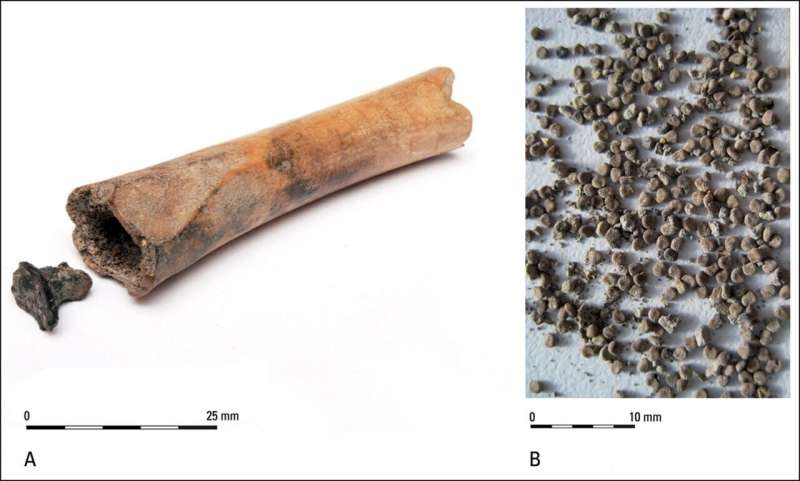This article has been reviewed according to Science X's editorial process and policies. Editors have highlighted the following attributes while ensuring the content's credibility:
fact-checked
trusted source
proofread
Painkiller or pleasure? First conclusive evidence found for intentional use of black henbane in the Roman world

A team of archaeologists led by Dr. Maaike Groot from Freie Universität Berlin has provided the first firm evidence that the Romans deliberately collected and used the poisonous seeds of the black henbane plant.
The team analyzed seeds found in a hollowed bone discovered at the Roman-period settlement of Houten-Castellum in the Netherlands and compared them to other archaeological occurrences of the plant. The results of the study were published in the journal Antiquity.
The team's findings support the accounts of classical writers such as Pliny the Elder, who discuss the plant's medical applications as a remedy for ailments, including fever, cough and pain. "Our results indicate that Roman medical practices even extended to rural communities on the Empire's periphery," explains Groot.
Previous research suggests that the bone may have been a pipe used to smoke henbane, as the seeds are also known to produce hallucinogenic effects. However, these seeds were not singed in any way, and there was a lack of evidence for burning on the pipe. Furthermore, it would have been deadly to smoke the hundreds of seeds stored within the pipe, implying that it was instead a container for storing the seeds.
"Since black henbane can grow naturally in and around settlements, its seeds can end up in archaeological sites simply by chance. This makes it difficult to prove if it was used intentionally by humans—whether medicinally or recreationally," says Groot. "The fact that, in our case, the seeds were found inside a hollowed-out sheep or goat bone sealed with a black birch-bark tar plug indicates that the henbane was stored there intentionally, and it was not used for smoking."
There have only been four other occurrences of black henbane found by archaeologists in north-western Europe that indicate it was being used intentionally. Only one of them, from medieval Denmark, was found in a container. The seeds that Groot and her team examined represent the first example of black henbane seeds to be found in a container from the Roman period. The study makes an important contribution to the discussion of how to distinguish between weeds and cultivated plants in archaeological contexts.
More information: Maaike Groot et al, Evidence of the intentional use of black henbane (Hyoscyamus niger) in the Roman Netherlands, Antiquity (2024). DOI: 10.15184/aqy.2024.5
Provided by Free University of Berlin


















